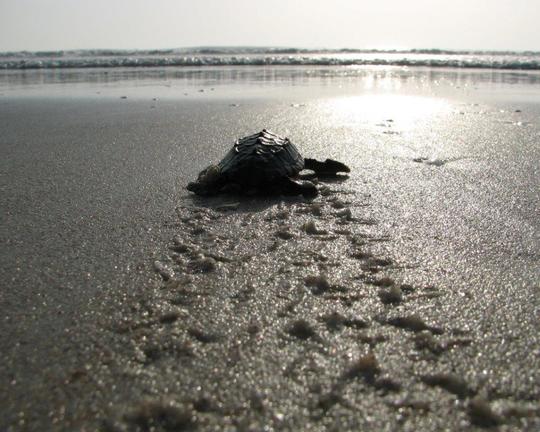PRESS RELEASE: May 19, 2015
FIRST LOGGERHEAD
TURTLE NEST OF SEASON SPOTTED
~Marine Turtle Patrol
discovers nest at GTM Research Reserve~

PONTE VEDRA BEACH, Fla. – Guana Tolomato Matanzas National
Estuarine Research Reserve (GTM Research Reserve) Marine Turtle Patrol
volunteers have spotted the first loggerhead sea turtle nest of the nesting
season, which runs from May to September.
The Marine Turtle Patrol program
is a volunteer-based effort for monitoring and evaluating sea
turtle nests on the GTM Research Reserve's beach. In April,
volunteers began monitoring and evaluating sea turtle nests seven
days a week. Volunteers also educate the community about sea turtles
and the patrol program through interactions with beachgoers and the reserve’s
educational lecture series.
"Our Marine Turtle Patrol
volunteers are very dedicated," said Shannon Rininger, volunteer
coordinator at the GTM Research Reserve. "Some drive long distances and
arrive before the sun is up to prepare for their morning patrol."
The Marine Turtle Patrol begins at dawn
each morning, traversing the almost 8 miles of reserve beach looking for
new turtle crawls. When a new crawl is located, the patrol team determines
if it’s a nest or a false crawl, which is when nesting turtles come onto the
beach but do not lay eggs. Nest locations are documented with a GPS reading
and then staked and ribboned off to protect the section from surface
disturbance. The nest is numbered, and a Florida Fish and Wildlife Conservation
Commission sign is placed at the site, informing individuals that those who disturb the nest
are subject to fines and imprisonment according to Florida Law Chapter 370 and
the Endangered Species Act of 1973.
An average marine turtle nest contains
between 80 and 120 eggs. If incubation goes well with little to no predation or
overwashing, hatchlings will emerge 50 to 60 days later. Three to five
days after the hatching, the patrol returns to the nest to determine its
success rate: how many eggs hatched or did not and the status of any remaining
hatchlings. If found early enough in the morning, any remaining hatchlings will
be released on the beach to find their way to the water. This action helps the
turtles imprint on their natal beach, where they will return in about 30 years
to nest on their own.
Loggerhead turtles are considered an
endangered species and are the largest of all hard-shelled turtles, with
characteristic large heads, strong jaws and a reddish-brown shell or carapace.
During the three months that a female loggerhead breeds, she will travel
hundreds of miles to nest, lay more than 35 pounds of eggs and swim back to her
home foraging area, all without a significant meal.
During sea turtle nesting season, the
public is encouraged to avoid any interaction with nesting turtles and remain
clear of all marked sea turtle nests. Beachgoers are encouraged to flatten
sandcastles, fill in any holes dug in the sand and take all personal items such
as chairs or toys when leaving the beach. These items can become
obstacles to nesting turtles and could cause them to abort their nesting attempt
or could cause the turtle to become entangled. Residences on or near the beach
must adhere to a “lights off” policy for beach-facing lights or use special
fixtures to shield the lights from the beach after 9 p.m. Artificial lighting
can deter females from nesting or cause emerging hatchlings to become disoriented,
risking desiccation and death.
For more information about volunteering for the Marine
Turtle Patrol program, click here or contact Shannon Rininger, volunteer
coordinator at 904-823-4500.
|